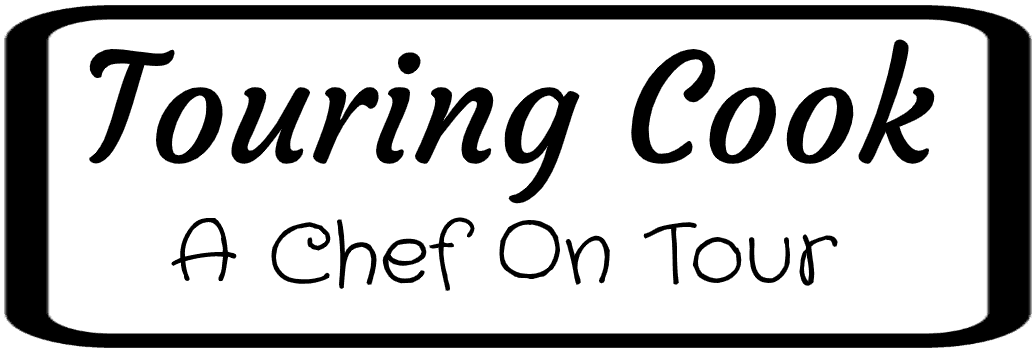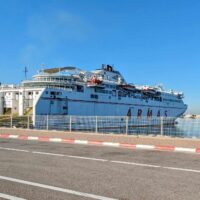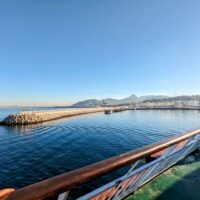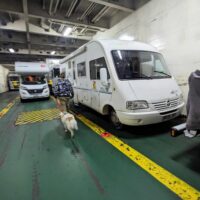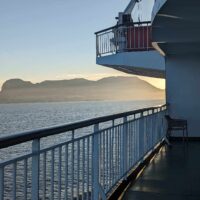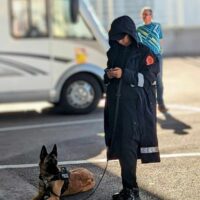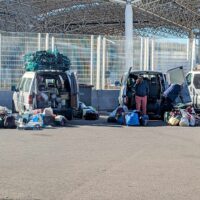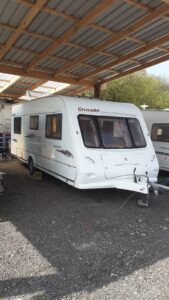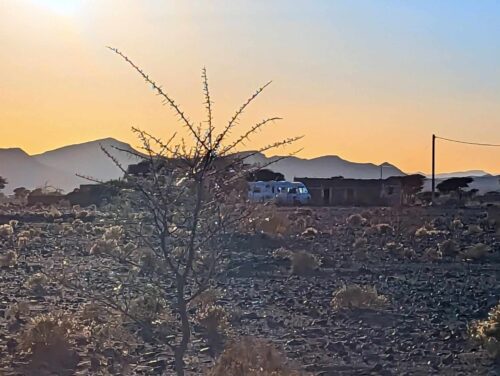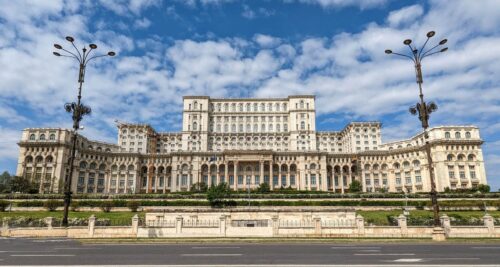In this post, I discuss our experience of taking the ferry to Morocco. The paperwork required, and how the process works.
- Arrived at the ferry port at 7.00 am. Tickets checked at the entrance.
- Followed signs for those with tickets. Each ferry has an allocated kiosk and staff in high viz direct you to correct queue.
- Dog passport checked whilst in queue. See separate post for travelling with a pet.
- At kiosk paperwork exchanged for ferry tickets, 7.40 am.
- Passport control, passports stamped.
- Joined queue for boarding.
- 8.00 am Boarded the ferry.
- 8.15 am Engines started.
- 8.30 am Ferry departed Algeciras.
- 8.40 am Completed personal information on the immigration entry card provided on the ferry and joined the queue for Moroccan Passport Control. Wait time is approximately 30 minutes.
- 9.55 am Arrive at Tanger Med.
- 10.00 am Disembarkment started. Passports checked again as we drove off.
- Long drive (follow exit signs) to the customs checkpoint. Hand over passports and logbook (V5).
- Be prepared to be asked to leave your vehicle and maybe empty out some of the lockers so the sniffer dogs can gain access.
- 11.40 am Customs officer returned with the D16, vehicle import document.
- 11.45 am Another check as you exit customs to ensure you have the D16.
- Before you exit the port there is an area with ATMs, foreign exchange, insurance brokers, and vendors of SIM cards.
- By the time we had sorted insurance, sim cards, cash, and had some lunch it was approximately 1.00 pm
Ferry Tickets
Ferry tickets are on sale in numerous places. There are many agents selling them on the approach roads to the port towns as well as in places like Tarifa or Algeciras. You can also buy directly at the ports. In fact, there are so many places selling them that shopping around could be somewhat daunting.
We chose to use an agent, Carlos, based in Algeciras. He has been trading for some considerable time and has a good reputation. Maybe occasionally a little more expensive, but the staff are knowledgeable and speak some English, making the whole process a little easier and they are able to answer any questions you may have. We also got cake and wine – a tradition Carlos started when he first began and continues to this day.
The ferry tickets are “open” both ways, meaning that you can travel at any time convenient to you without worrying about being booked onto a specific sailing. For us this was important because we have no idea when we will be returning to the EU.
Algeciras Port
The Crossing
The crossing itself was plain sailing. Smooth seas and blue skies. It was a real treat to see Gibraltar from a different perspective, and we were lucky enough to see dolphins, albeit in the distance.
Moroccan passport control is based on the ferry. You collect an immigration entry card, freely available on the ferry. Complete it and take it to the passport control office. It was quiet on our crossing so there was just a small queue and still took 30 minutes, but at busier times there will be more than one officer on duty, and they use a ticket system similar to that used at a supermarket deli counter. Carol tried to do for both of us as Zeus wasn’t allowed inside but I had to go and collect my passport so they could verify it was me.
Moroccan Customs
Past Customs
Once you have passed through customs you are free to leave the port and continue your journey.
However, there is an area, with ample parking, where there is an array of kiosks where you can get insurance, SIM cards, foreign exchange, and ATMs.
Given that Morocco is largely a cash-based economy we availed ourselves of an ATM. We also purchased 3 months insurance (3rd party) for the motorhome and a SIM card (15 euros for 15 Gb).
What you can and can't take into Morocco
What you can take with you:
• Clothes for personal use.
• Tobacco (200 cigarettes, 100 cigarillos, 25 cigars, or 250 grams of loose tobacco).
• Alcoholic drinks (1 l bottle).
• Jewellery, perfumes (150 ml) and toilet water (250 ml).
• Souvenirs, presents whose value should not exceed 2000 DH.
• Camera, camcorder, binoculars, or CD player.
• Tape recorder, radio, TV, camera, typewriter, calculator, portable computer, mobile phone.
• Sport fittings
• Musical instrument
• Bicycle, tandem, bicycle having an auxiliary motor.
Prohibited items include:
• Arms and ammunition.
• Drugs
• Books, printed matter, audio and video cassettes, and any other immoral items liable to cause a breach of the peace.
Restricted items include:
• Plants
• Endangered species of wild fauna and flora
• Hunting arms and their ammunition
• Medicines (allowable In small quantities for personal use – medical proof (medical certificate, prescription, etc), may be required)
• Drones (will get confiscated at border)
• Currency: you cannot take more than 2000 DH in cash into or out of the country. If you have more than the equivalent of 100,000 DH in any currency with you it must be declared in order to re-export it in part or in full on exit.
Make sure you check your local government advice and the advice from the Moroccan Embassy before travelling
And that was our experience of taking a ferry to Morocco. It was actually fairly straightforward and logical but took longer than you might expect. Between arriving at Algeciras and leaving Tanger Med took approximately 6 hours so allow plenty of time.
I hope this helps, and happy travels.
Hope You Enjoy!
Please leave us a comment!
